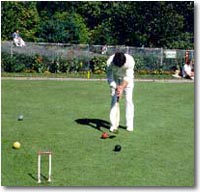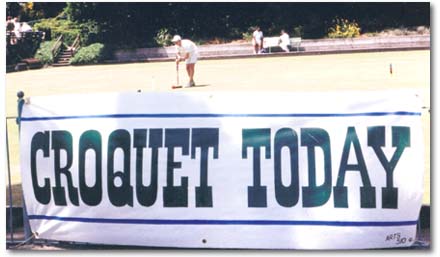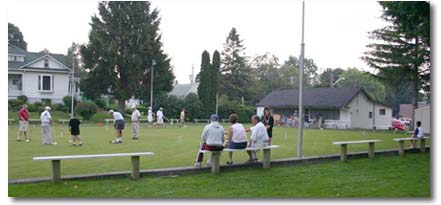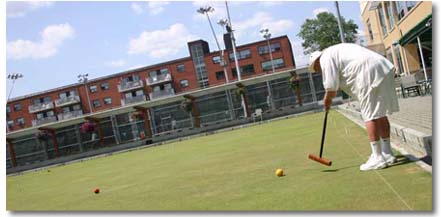

|
Back to |
| The Front Page |
| News & Features |

|
Bowlers and croquet players choose war or peace |
|
by Bob Alman Photos by Don Oakley, Ken Shipley, and Bob Alman Posted September 12, 2010
|
It isn't inevitable that groups in the same space become bitterest enemies - although you might think that by considering the Arabs and the Israelies in Palestine, the Bloods and the Crips on the streets of urban American ghettos, or lawn bowlers and croquet players in some spots on Planet Earth. In fact, the practical, financial, and scheduling benefits of sharing turf is trumped only by the innate extreme territoriality of our primate species. Lawn bowling is high-density, with playing periods typically organized for as many as 40 or more bowlers on one lawn at several scheduled periods a week. During the lawns' "rest" periods, scheduling them for croquet with it's lightweight balls and sparse traffic produces extra income to maintain and expand joint facilities. Appealing to the better nature of both groups, happy outcomes are becoming the rule rather than the exception.

|
| The two bowling lawns in Manhattan's Central Park were the first municipal lawns used for croquet, virtual headquarters for the fledgling USCA organized there in the 1970's. This precedent was not noticably useful in generating shared use agreements in the United States, when the Palm Beach establishment at the time actively disparaged "public court croquet." Now public court facilities with three lawns or more are the leading edge of USCA expansion. |
For the most part, bowls and croquet have occupied different spaces in England and the Commonwealth for more than 100 years, but in America, croquet wasn't organized until the 1970's, and the initial approaches of croquet players to entrenched lawn bowling clubs were met with hostility. The bowlers were there first, and they quite properly regarded the croquet players as interlopers.

|
| A huge banner on the fence between the bowling lawn and a busy thoroughfare in Golden Gate Park during the San Francisco Open alerts passersby to something different happening. |
Whenever and wherever the lawn bowling club has enjoyed a free ride or a cheap ride by the entity supporting it - usually a city park department - there has been no reason for bowlers to embrace the idea of sharing, and that's the situation that has given rise to many sad tales of defeat for flegling croquet clubs in America. On the other hand, when the owners - either private clubs or government entities - value the economic use of their facilities by many people for many uses, making a persuasive argument for dual use is easy.
The Oakland Horror Story
When I contacted the Oakland Park & Recreation Advisory Commission to propose having croquet as well as bowling on two of the three under-utilized greens of Oakland's Lakeside Park, the bowling club had no good reason for being enthusiastic about the idea. But after a long series of explorations and experiments - all opposed by the lawn bowling organization - the Advisory Commission recommended unanimously to the Oakland City Council that croquet be allowed on the greens.

|
| Wayne Rodoni installs "spear hoops" on the Oakland Croquet Club's main lawns for the 1997 USCA National Championships, rented while negotiations for shared use were under way. The stanchions have a regulation diameter of 5/8" but no carrots or fins projecting from the sharpened posts, leaving a small footprint that virtually disappears in a few days after removal. Sufficient stability is created by extra length. Spears work especially well in hard ground. |
(Memo to enlightened city fathers everywhere: Create your Advisory Boards of impartial and nonpolitical citizens who can put some teeth in their recommendations. Otherwise, you'll see the Oakland story repeated in your city. If you want an example of a town where the Advisory Board has power to implement their recommendations, look across the bay to San Francisco.)
All that was in the 90's. The finances of Oakland have radically changed in the meantime, arguing for different solutions. Thanks largely to the efforts of a croquet player named Dave Dondero who happened to be a long-time employee of the City of Oakland as an arbitrator, the Oakland Croquet Club was finally allowed, early in this century, to play on the third and distinctly inferior bowling lawn, with no access to the clubhouse. But the City of Oakland, now nearly bankrupt, have told the lawn bowling club, declining in membership, that the City can barely afford to maintain the lawns. Members of neither club may legally do the work required for lawn maintenance because of the strong municipal union presence and liability issues. The bowlers historically have had very low club dues and now must maintain the clubhouse with no help from the city, with shrinking membership.
The financial arrangement insisted upon by the bowling club has the one-lawn croquet club give them rent directly, instead of the City of Oakland, so the croquet club, on the back lawn of the three, has slight physical, organizational or financial presence. The original proposal in the 90's allowed the croquet club to have two lawns, on a rotating basis, ensuring the bowlers the best greens and the pick of the schedule, while affording the croquet club space to grow. With only one lawn, however, the growth of the Oakland Croquet Club has been stunted, so their ability to generate funds is limited, despite the fact that they pay higher dues than the bowlers and get fewer benefits, playing on an inferior lawn, and with no access to the clubhouse.
One can only imagine what the prospects for this facility might look like today had the Oakland City Council in the late 90s accepted the unanimous recommendation of their Parks & Recreation Advisory Commission. How many dues-paying members might the Oakland Croquet Club now boast, thriving with space to grow on two lawns, in an ideal year-round California climate? How might the sight of lawns filled with bowlers and croquet players actually paying their way have affected the financial decisions of the Oakland city fathers?
Happy endings from coast to coast in Canada
Go just north of the border, however, and you will discover in Canada a virtual paradise of felicitous shared use of greens. Yes, it could be partly because the Canadians are more enlightened and less up-tight than their neighbors to the south. But other circumstances in Canada, from coast to coast, help to produce a strong desire on the part of the bowlers and croquet players to cooperate in achieving mutual goals. Those circumstances are both organizational and financial. In Canada, the municipalities actively encourage private clubs on public turf to pay their way. And the municipalities usually control the greens they own, rather than the entrenched private clubs.

|
| Croquet Canada is privileged to use Ottawa's unusually flat and fast Elmsdale Lawn Bowling Club lawn for major events, including the 2009 CroqCan. Here's Palm Emmett showing off his form. |
These circumstances have made Canada a world-wide model for shared use, after organized croquet began in Canada as an offshoot of USCA croquet, started in the 1970's.

|
| Croquet is a regular part of the scene at the Brighton Lawn Bowling and Croquet Club, Ontario. |
The situation in Ottawa, with two shared facilities, is not untypical. It's well known in lawn bowling circles in the Ottawa area that the croquet players saved the Central Lawn Bowling Club from failing when croquet players took over care of the green and the grass perimeter more than a decade ago in the 1990's. Former Croquet Canada presidents Louis Nel and Ken Shipley report that in recent years the lawn bowling faction at Central has continued to fall in membership and can no longer pay their share of what the croquet club spends on maintenance each year. According to Shipley, "We haven't made an issue out of it, we just thank them for whatever they are able to contribute and keep things going with our cadre of volunteers and money from the croquet side."

|
| Top-ranked Canadian Leo McBride plays on the shared green of the Toronto Cricket, Skating & Curling Club in the 2008 CroqCan Golf Croquet Nationals. |
This approach is seen not just in Ottawa either. According to Louis Nel, "Paul Emmett's club changed its name some years ago to the North Toronto Lawn Bowling and Croquet Club, and they have a joint executive where Paul has taken his turn as president for a couple of terms and they work together very well."

|
| A restored bowling lawn on a high-traffic corner in a park will be a boon to both the Central Lawn Bowling Club and Ottawa's croquet players. Ken Shipley of Croquet Canada is pushing the city for full restoration, including the ditches, with the argument that attracting new players to both sports would increase the ability of these clubs to support maintenance. Some upgrades have been done since this picture was taken. |
Bowling lawns in Canada - as in the US - are still largely underutilized and under increasing financial pressures as revenues to support public facilities are squeezed with ever-tighter budgets in a worldwide recession. The economics of shared use argue more strongly than ever for cooperation, friendship, and mutual support among bowlers and croquet players. Two people cannot live as cheaply as one, but in fact, two sports really can occupy the same space almost as cheaply as one, with just a little bit of good will, inspired by enlightened self-interest.

|
| The greenskeeper for Ottowa's Elmdale Lawnbowling Club became an advocate for croquet when he reported the relative lack of lawn damage and wear from lightweight balls and low traffic density. |
A bitter turf war raging in New South Wales
An Australia newspaper report from mid 2010 says in part, "The genteel sport of croquet has been played on the Hampton Park Reserve in Ballina since at least 1936, when the Ballina Croquet Club was formed. But in 1985 (when relations between the bowlers and the croquet players were much more cordial than they are today), the bowling club approached the croquet club about taking over their patch of the park in exchange for a new clubhouse and new croquet lawns. The offer was accepted, but set in motion a series of legal and procedural minefields, which have exploded with increasing frequency over the past few months.
"At the heart of the dispute is the question of who has the legal and moral right to the lease of the Crown land on which the greens are situated.
"The bowling club says it does because it paid for the clubhouse and the lawns. But the croquet club says they do because they have been paying council rates on it and the land is designated for the use of “mallet sports”. Recently Ballina Bowling Club started their own croquet club to comply with this requirement."
"Despite a peaceful protest, the Ballina Croquet Club has been unsuccessful in being named the lease-holder for the Ballina croquet greens, with the NSW Minister for Lands Tony Kelly determining that the lease remain with the Ballina Bowling and Recreational Club." And so the ongoing hostilities - high comedy as depicted in an excellent TV news video lampoon - is causing endless grief to the otherwise perfectly nice folks in all three clubs. We can only wish them well.
Throughout Australia generally, croquet under the broader banner of "malletsports" seems to be on the upswing while bowls declines. Australian coach John Riches reports that in South Australia a few croquet clubs are allowed to use bowling greens for their major tournaments. In Adelaide, the state croquet headquarters facility and four of the largest clubs have all taken over lawns and clubhouses from bowls clubs which have become unsustainable and disbanded or amalgamated with other nearby bowling organizations.
Typically, croquet and lawn bowling clubs control their own destinies with little interference and pay only modest annual rents for their lawns and clubhouses on public land owned by the local governmental councils. Full-time joint use of lawns for bowling and croquet is little seen in Australia.
But all's peaceful in England
In the meantime, in fair England, where all these cherished lawnsports were developed to their full potential, peace reigns for the most part. As reported by James Hawkins, "Problems of coexistence between the two games don't arise often in England. The more usual lawnsport combo is tennis and croquet, where croquet always seems to come off second-best. This is, perhaps, rooted in the history of the three sports; bowls was the pursuit of working class Northerners in industrialised factory towns, croquet and tennis were games for the Southern middle classes to play at home. Where croquet existed on an organised basis - mostly in the southwest and along the south coast - the rapid growth of lawn tennis quickly and almost totally supplanted the earlier game, not least at the All England Croquet Club in Wimbledon.
"Heaton Park in Manchester is perhaps the best example of shared use, hosting two bowling clubs as well as croquet when needed by the Bury Croquet Club, whose home turf is a mile or two down the road at Coronation Park. (Heaton Park is where the Australia/New Zealand test was played in the 2010 MacRobertson Shield matches.) It's an unusual arrangement, tied up in the legacy agreement of Manchester's hosting of the Commonwealth Games at the venue - two autonomous clubs playing the same sport on the same ground at the same time. The croquet club, as occasional user of the site, can rise above the day to day scheduling quibbles, and accesses the facility by mediation with the Manchester City Council, the owner."
Hawkins opines, "Bowls in the UK seems to have an image of retired working-class men. Historically, provision of facilities could have been taken for granted - whether at a municipal park, social club, employers' sporting facility, or public house. Now, with most clubs under private control, and relying on self-governance by the members, there seems to be a grumpy, uncompromising attitude when things aren't exactly how they want them. Croquet players are much more a roll-your-sleeves-up-and-get-on-with-the-work kind of group. Croquet and Bowls get along just fine, but Bowls and Croquet less so."
Do you have a story - for good or ill - to add to this international view of shared use? Whether you're a croquet player, a lawn bowler, or that rare combination of both, we invite you to share it in on our self-posting BULLETIN BOARD. Just follow the instructions, and let us know if you run into trouble.